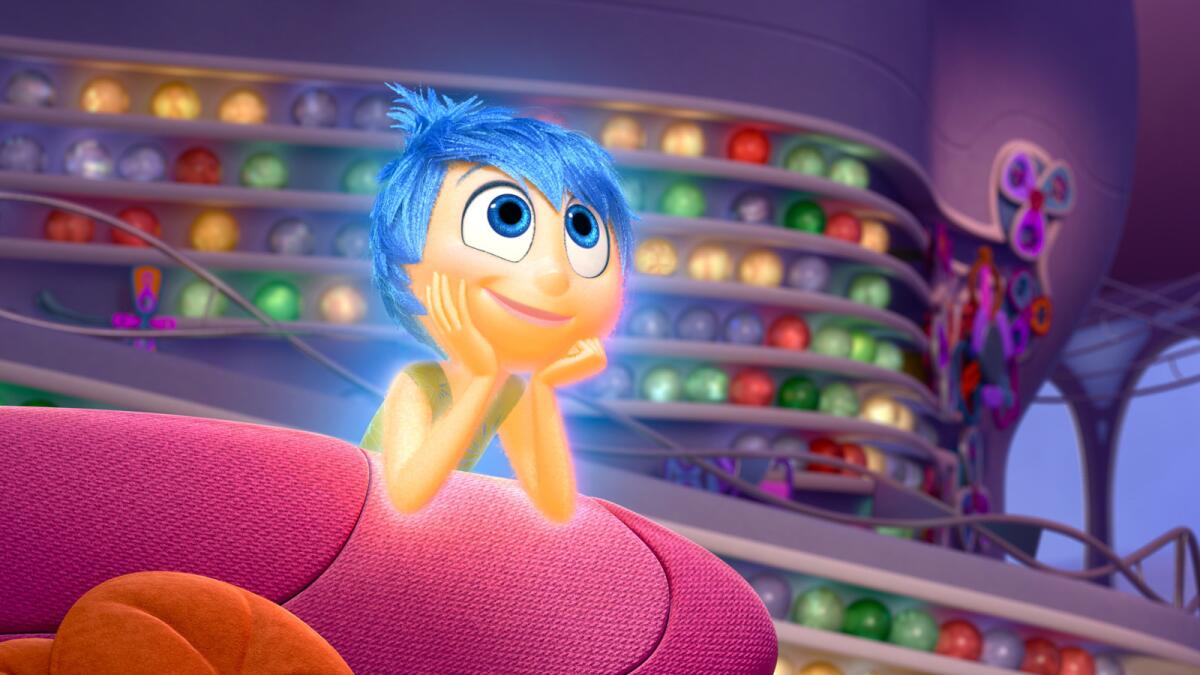‘Inside Out’: Is box office facing a wealth-gap problem?

“Inside Out’s” big numbers shouldn’t be taken in isolation. It has been boom time for the domestic box office generally, which year to date is up 6.1% over last year and 7.8% over 2013.
“Inside Out” this last weekend became the third mega-blockbuster of the summer season, and the fourth of the year once you include the April release of “Furious 7.”
With an opening total of $90 million, Pete Docter’s animated head trip will easily surpass $200 million domestically when all is said and done, and has a very good chance of cracking $250 million. Sure, it may have a hard time reaching the top layer of Pixar originals -- “Finding Nemo” and “Up” each have more than $325 million domestically when adjusted for inflation. But it will still be in Pixar’s upper tier, ahead of “Brave,” “Ratatouille” and other solid original hits.
“Inside Out’s” big numbers shouldn’t be taken in isolation. It has been boom time for the domestic box office generally, which year to date is up 6.1% over last year and 7.8% over 2013. With the first half of the year set to wrap after this coming weekend, the question is how the film business has gotten here -- or, more specifically, how many movies have helped it get here?
There are, broadly speaking, two ways a year-over-year box office increase happens. It could be driven by a proportional jump across a wide range of movies. Or a precious few could disproportionately skew up the total.
The increases we’ve been seeing are decidedly -- some would say concerningly -- in the latter camp. Here’s how the data break down.
This year, the top five releases through June 30 -- “Avengers: Age of Ultron,” “Jurassic World,” “Furious 7,” “Cinderella” and, shortly, “Inside Out” -- will average $336 million (and that’s assuming conservative estimates of “Jurassic World” at $350 million and “Inside Out” at $225 million). That $336 million average is a massive increase over last year at this time, when the top five only averaged $228 million.
So far, so good. But what’s interesting is what happens when you look down the line past the top five. The next 10 films this year will average $140 million. That number should also crush last year’s, right? It doesn’t. In fact, it’s not much higher than last year’s field at all, which averaged $136 million.
Which means that the growth is heavily concentrated right at the top. Those who aren’t super-rich? They’re lagging behind.
Or, in percentage terms: The top five this year account for 55% of the top 15’s box office. Last year, the top five accounted for only 46% of the top 15.
Go back another year and the numbers were a little closer. In the first half of 2013, the top five composed just over 50% of the top 15. But it’s still lower than this year.
Disparities between the top five and the movies behind it are normal, of course -- higher earning power is what makes the upper class what it is. What gets economists (and, potentially, should also have entertainment pundits) worried is when the numbers start to widen over time.
As with the super-rich, a handful of films seems to be driving the gap. The biggest of these Warren Buffet types is “The Avengers.” In 2012, “Avengers” spiked the top five as a share of the top 15 to a whopping 58%, taking it over the far more equitable 2011 (45%). This year it, well, we know what it did.
Overall, increases in box office receipts are a good thing as far as the health of the movie business goes. Growth is nice, no matter where it comes from.
Culturally, though, it’s troubling. If the overall level of moviegoing is rising, but the overall number of movies people are seeing is shrinking, that means less diversity all around. More of the country is now seeing fewer movies. And that has an effect all the way up the chain, as studios stop making mid-range movies and concentrate on an ever-fewer number of titles it hopes can become the next “Avengers.” Yes, we’ve been hearing about the death of the middle, and even the upper middle, for a while now. But this year’s numbers provide some of the best evidence, if you’re a studio executive, for keeping it inanimate.
And as it turns out, the business health point isn’t entirely true either. It’s healthy if you’re an exhibitor, because you don’t really care if all of the country is seeing 100 movies, 10 movies or one movie, as long as box office receipts are up. The studios, on the other hand, do care -- especially those studios without a mega-hit. And interestingly, there’s a miniature wealth gap playing out here, too. The box office top five so far this year comes from just two studios -- Disney and Universal. Those looking for Sony, Paramount, Warner Brothers, Fox or Lionsgate on this list will come up with nada.
What’s interesting is how this is all happening in the supposed era of the long tail, in which technology has made the flowering of riches possible for everyone, elevating movies few would have heard of to prominence and keeping movies in play for weeks and months at a time.
The long tail does have some truth -- but mostly at the low end of the scale. Just ask indie filmmaker Noah Baumbach, who has racked up his best-ever total with “While We’re Young,” still selling tickets three months into release as it approaches $8 million. Or the Weinstein Co.’s specialty release “The Woman in Gold,” which while we weren’t looking topped $30 million, and actually doubled its number of theaters this last weekend, also nearly three months into its run. But look at the mid-range movies, and they’re getting squeezed.
No one likes a Gloomy Gus when things are good. But not all box office increases are created equal. As moviegoers see, and Hollywood celebrates the success of movies such as “Inside Out” and “Jurassic World,” it’s worth asking what kind of films will come in their wake -- and, more important, if we’ll see a very wide range at all.
Twitter: @ZeitchikLAT
More to Read
Only good movies
Get the Indie Focus newsletter, Mark Olsen's weekly guide to the world of cinema.
You may occasionally receive promotional content from the Los Angeles Times.







